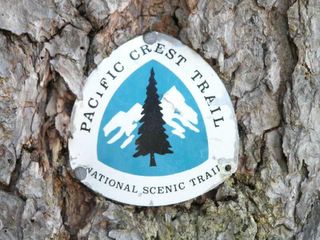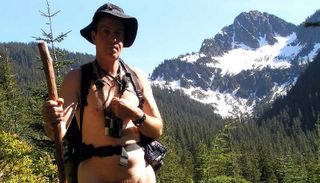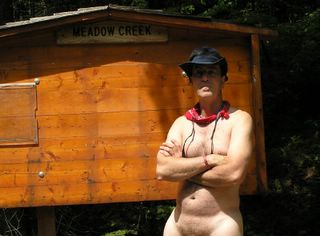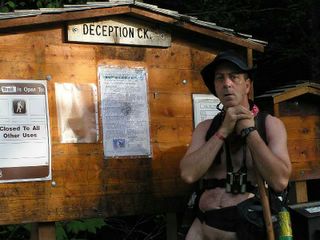Take a Nature Hike Amongst the Trees (au' natural of course)
A naturist is said to be one who strives to become one with nature and I certainly backpack and hike in such a way that I take the time to 'smell the roses' and let my senses soak in everything they can about my environment. In many ways the NATURIST is very much like the NATURALIST . . . except, of course, we enjoy our surroundings without any clothes on.
Hiking the trails presents a diverse plethora for the senses. A tree is just not any old tree. There are many types of trees and they say alot about the environment and terrain we are hiking through. When we open up all our senses and take this in we learn not only about the trees but we learn about the entire ecosystem . . . flora and fauna both . . . and perhaps a little bit about our place in this wonderful place.
In the Cascades of Washington we can see and experience several different types of trees such as: the Cypress, Douglas-fir, Hemlock, Incense-cedar, Juniper, Larch, Pine, Red Cedar, Spruce, True Cedar, True Fir, White-cedar and the Yew. Each of these trees grows in prefered environments and locations and it is interesting and educational to see the nature of the forest change as you gain altitude or perhaps arrive on a northern-facing slope.
I wish to acknowledge Oregon State University whose website (the link in the title) provide just about all the information in this article. I have only consolidated that volumnous data to concentrate on the Washington State Cascades area. We start with the most common tree, the pine.
The Pines (Pinus)
- Long, narrow needles are bound in bundles resembling whisk brooms.
- Fruits are large, woody cones with thick, tough scales.
- Branches commonly grow in distinctive "whorls" or rings that make their trunks easy to climb (each whorl represents 1 year's growth).
On a world-wide basis, pines are the most common type of conifer; there are nearly 100 different species. North America alone has over 30! In general, pines are easy to distinguish from other needle-leaved trees because of their long, narrow needles bound in bundles; large, woody cones with tough scales; and distinctive "whorls" of branches that make their trunks easy to climb.
Pine forests are also distinctive. In general, pine trees like a lot of light, so pine forests are open and sunlight spills through to the forest floor. Wind moving through their long needles also gives pine forests a distinctive sound, and no one can miss their unique fragrance.
Eight species of pine are native to the Pacific Northwest, although many others have been introduced. Four pines (lodgepole, sugar, ponderosa, and western white) were named by Scottish botanist David Douglas. Apparently this diversity surprised even him, for he wrote to his employer at the Royal Horticulture Society of England, "you will begin to think that I manufacture pines at my pleasure".
To identify pines, count the needles in each bundle. This will divide the species into smaller groups. Then check the range and the appearance of the cones to pinpoint the species.
- Two needles per bundle: LODGEPOLE
- Three needles per bundle: PONDEROSA, JEFFREY, and KNOBCONE
- Five needles per bundle: WESTERN WHITE, SUGAR, LIMBER, and WHITEBARK
The Pines Common in the North Cascades: Of the eight species of pine only four are common to the Washington slopes of the Cascades. They are:
lodgepole pine (Pinus contorta)

Lodgepole Pine

- Needles: Two needles per bundle (clustered); 1-3" long; commonly twisted (contorted).
- Fruit: Small, egg-shaped cones (1-2" long), often with a prickle at the end of each scale. May remain closed on the tree for years.
- Bark: Thin, dark, and flaky.
- Distribution: Abundant in the northern Rocky Mountains and Pacific Coast region. Grow from 0-11,500 ft. (0-3600 m). Those along the coast are commonly called shore pine.
ponderosa pine (Pinus ponderosa)

Ponderosa Pine

- Needles: Occur in bundles of 3 (rarely 2); 5-10" long; tufted near the ends of branches (needles are held only 2-3 years).
- Fruit: Egg-shaped cone; 3-5" long; each scale has a straight, stiff prickle that sticks out.
- Bark: Flakes off in shapes like jigsaw puzzle pieces. Older trees have a distinct yellow or orange color.
- Distribution: Occurs in the Pacific Coast mountain ranges, throughout the Rocky Mountains, and into northern Mexico. Grows from sea level to 9000 ft. (2800 m).
western white pine (Pinus monticola)

Western White Pine

- Needles: Occur in bundles of 5; 2-4" long; white lines on 2 sides of each needle.
- Fruit: Woody cones, 5-12" long (smaller than sugar pine cones); slender and curved. Cone scales are thin and often curve up on the end.
- Bark: Dark; broken into small squares or rectangles on older trees (smooth on young trees). Bark often "ringed" where a whorl of branches once grew.
- Distribution: Occurs in southern British Columbia, the northwestern states, and the Sierra Nevada of California. In the northern portion of their range, the trees grow from sea level to 2500 ft. (750 m).
whitebark pine (Pinus albicaulis)

Whiteback Pine

- Size: Usually under 50' tall and 2' in diameter. Often distorted or shrub-like.
- Needles: Occur in bundles of 5; 1-3" long; faint, white lines on all surfaces.
- Fruit: Small, woody cones, 2-3" long; nearly round; thick cone scales with no prickles. Remain closed on tree even when mature; Seeds are unwinged and a rich source of food for animals.
- Bark: Thin, scaly, and grayish throughout its life.
- Distribution: Found in the high mountains of western Canada and the U.S. Grows at or near timberline from 7700 to 12,000 ft. (2350-3750 m) elevation.
True Firs (Abies)
- Erect cones perch on the topmost branches; scales fall off cones when seeds ripen.
- Twigs have tiny, circular leaf scars.
- Young stems have fragrant resin blisters; buds are rounded and are often covered with resin.
True firs are so named to distinguish them from Douglas-firs, Chinese-firs, and a number of other pretenders. Sometimes they're called "balsam firs" because of tiny pockets of resin, or balsam, that occur in their bark. About 40 species of true firs grow in cold regions of the northern hemisphere. True firs are well-adapted to snowy environments because their short, stiff branches and pointed tops shed snow without breaking.
Seven species of true fir are native to western North America; four are native to Washington: grand fir, noble fir, Pacific silver fir and subalpine fir.
All true firs have the following characteristics:
- Cones that perch like little owls on the topmost branches--so, look aloft for large, erect cones. They often glisten with drops of fragrant, sticky resin.
- Cones of true firs do not fall intact like other conifer cones. In late fall, their scales tumble off one by one when the seeds have ripened. As a result, cones can only be used to recognize true firs in summer and early fall.
- Gently pull a needle away from its twig and notice the tiny, circular scar left on the twig. This circle makes it easy to recognize a true fir at any season.
- Young stems have fragrant resin blisters. Stick them with your finger and they pop, oozing a clear liquid. Resins and oils from the bark and foliage of true firs are used for a variety of products, including perfumes, adhesives, and pharmaceuticals. Some attribute a healing effect to this liquid.
- The buds of true firs are rounded and are often covered with resin, wax, or curved needles. Buds near the ends of twigs often occur in clusters of three or more.
The True Firs common in the North Cascades
grand fir (Abies grandis)

Grand Fir

- Needles: About 1" long; yellow-green on top surface of needles (no white bloom on upper surface)--whitish bands on undersides. Sets of needles flattened or "V" shaped. Needles are two distinct sizes, with alternating long and short needles.
- Fruit: Upright, cylindrical cones; 3-4" long; bracts shorter than scales. Fall apart when mature.
- Twigs: Terminal buds round and clustered, and covered with resin. Young twigs are greenish.
- Distribution: Extends across the Pacific Northwest from sea level to 5100 ft. (1600 m).
Pacific silver fir (Abies amabilis)

Pacific Silver Fir

- Needles: Green on top and white underneath; about 1" long. Top needles point forward like ski jumpers.
- Fruit: Large woody cones (3-6" long); cylindrical in shape; purple in color. Fall apart when mature.
- Twigs: Buds clustered at tip of branch are usually round, purple in color, and covered with pitch.
- Bark: Remains gray throughout its life. Resin blisters when young; scaly when older.
- Distribution: Grows from 1100-6600 ft (350-2000 m) elevation in the Pacific Northwest on southern and western exposures.
noble fir (Abies procera)

Noble Fir

- Needles: White on both surfaces; about 1" long; shaped like a hockey stick. Massed on the upper surface of the twig. A tiny groove runs the length of the upper side.
- Fruit: Large woody cones (4-6" long); cylindrical in shape; have distinctive bracts that look like elephant heads. Fall apart when mature.
- Twigs: Reddish-brown. Buds clustered at the terminal end are usually round, and are over-lapped by curved needles.
- Distribution: Occurs along the Pacific coast in Washington, Oregon, and northern California. Commonly found at 3200-5600 ft. (1000-1700 m) elevation on the west side of the Cascade Mountains.
subalpine fir (Abies lasiocarpa)

Sub-alpine Fir

- Needles: White lines both above and below the needle; about 1" long. Massed on the upper surface of the twig; very neat in appearance.
- Fruit: Cylindrical woody cones about 2-4" long; purple. Fall apart when mature.
- Twigs: Terminal buds are small, round, and clustered; covered with resin.
- Distribution: Generally occurs at timberline in cold, humid climates in the Olympic, Cascade, and Rocky Mountains.
Hemlocks (Tsuga)
- Short needles, generally under 1" long.
- Small, woody cones (1-3" long).
- Trees have distinctive droopy tops and branches.
Hemlocks are noted for short needles and droopy tops and branches. There are only about 10 species of hemlock in the world--mostly in North America, China, and Japan. The Pacific Northwest has two hemlocks: the abundant and commercially important western hemlock and the lesser known mountain hemlock. Even when found growing together, they're easy to tell apart. Thw western hemlock is the Wasginton State Tree.
- mountain hemlock: needles are blue-green on all surfaces, are similar in size, and are uniformly arranged around the twig. Clusters of needles often have a star-like appearance. Cones are cylindrical and are 1 to 3 inches long.
- western hemlock: needles are all very short, but have distinctly different sizes on the same twig. They are yellow-green on top, and have two white bands on their undersides. They tend to stick out the sides of the twigs, but also occur on top of the twig. Cones are egg-shaped and about 1 inch long.
mountain hemlock (Tsuga mertensiana)

Mountain Hemlock

- Needles: Between 1/2" and 1" long; blunt; blue-green in color; star-like appearance on short shoots.
- Fruit: Woody cones 1-3" long; thin, rounded scales.
- Twigs: Moderately stout; many short shoots; terminal branch tips have a natural bend; have small, rounded pegs (leaf scars) on twigs.
- Distribution: Grow on exposed ridges and slopes in the Pacific Northwest, and in the mountains of British Columbia and Idaho. Found at altitudes up to 11,000 ft. (3300 m).
western hemlock (Tsuga heterophylla)

Western Hemlock

- Needles: Short (under 3/4" long) and blunt; two distinctly different sizes; green above and white underneath each needle; most needles appear to arise from the sides of the twigs.
- Fruit: Small, woody cones (about 1"); egg-shaped; thin, smooth scales.
- Twigs: Thin and droopy; have small, rounded pegs (leaf scars) on twigs.
- Distribution: Primarily found in the coastal regions of the Pacific Northwest. Occurs from sea level to 7400 ft. (2250 m).
Douglas-fir (Pseudotsuga)
- Needles: About 1" long with a blunt tip. Needles are green above with 2 white bands underneath.
- Fruit: Woody cones 3 to 4 inches long; pitchfork-shaped bracts are longer than scales. Cones hang down.
- Twig: Large pointed buds with reddish-brown, overlapping scales.
- Distribution: Abundant in western North America from British Columbia to Mexico. Grows at sea level along the coast to 7000 ft. (2200 m) in the Cascades and Sierras, and to 11,000 ft. (3400 m) in the southern Rockies.

Douglas-fir is the name of an entire genus of trees that contains six species--two native to North America and four native to eastern Asia. Because of its similarity to other genera, Douglas-fir has given botanists fits. It has, at various times, been called a pine, a spruce, a hemlock, and a true fir. In 1867, because of its distinctive cones, it was given its own genus--Pseudotsuga--which means false hemlock. The hyphen in the common name lets us know that Douglas-fir is not a "true" fir--that it's not a member of the Abies genus.
Only one Douglas-fir is native to the Pacific Northwest, and it's by far the most important member of the entire genus. Its common name is identical to that of the genus, reflecting its importance. Douglas-fir (Pseudotsuga menziesii) is Oregon's state tree.
























